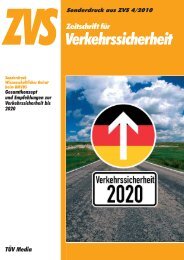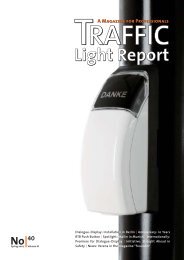No|46 - RTB GmbH & Co. KG
No|46 - RTB GmbH & Co. KG
No|46 - RTB GmbH & Co. KG
Create successful ePaper yourself
Turn your PDF publications into a flip-book with our unique Google optimized e-Paper software.
No | 46 No | Fall 2008 Volume 19<br />
46<br />
Fall 2008 Volume 19<br />
A Magazine for Professionals<br />
TRAFFIC<br />
Light Report<br />
Initiative: “Vision Zero” – Gaining Popularity | Technology: Intelligent<br />
Cable <strong>Co</strong>nnection | Innovation: Reliable Axle Recognition | Exhibitions:<br />
Trade Meeting in October | News: Tiefensee and the Dialogue-Display
2 | 3<br />
<strong>Co</strong>ntents.<br />
Publisher:<br />
<strong>RTB</strong> <strong>GmbH</strong> & <strong>Co</strong>.<strong>KG</strong>, Geschäftsführer Rudolf Broer<br />
Schulze-Delitzsch-Weg 10, 33175 Bad Lippspringe,<br />
Tel. + 49 (0) 52 52 - 97 06-0,Fax + 49 (0) 52 52 - 97 06-10<br />
e-mail:info@rtb-bl.de, www.rtb-bl.de<br />
Editor:<br />
HACK PR- und Werbeagentur <strong>GmbH</strong>, 33175 Bad Lippspringe<br />
Production:<br />
Machradt, Graphischer Betrieb, 33175 Bad Lippspringe<br />
INITIATIVE<br />
“Vision Zero” – Gaining Popularity<br />
A new way of viewing traffic safety<br />
TECHNOLOGY<br />
Intelligent Cable <strong>Co</strong>nnection<br />
net.1 creates attractive cost saving potential<br />
INNOVATION<br />
Reliable Axle Recognition<br />
Extended functionality now available with TOPO.plus<br />
EXHIBITIONS<br />
Trade Meeting in October<br />
Street and Traffic <strong>Co</strong>ngress 2008 in Düsseldorf<br />
NEWS<br />
Tiefensee and the Dialogue-Display<br />
Federal Traffic Minister prefers new solutions<br />
3<br />
4|5<br />
6|7<br />
8<br />
8<br />
About the cover picture:<br />
Putting on the final touches – Anja enjoys<br />
the successful results.
“Vision Zero“ –<br />
➲ A new way of viewing traffic safety<br />
Gaining Popularity<br />
Germany is tackling the problem of fatalities and injuries<br />
in street traffic with a new philosophy. “Vision Zero” is<br />
more than a program. It can, indeed, be compared to<br />
a humanistic approach. The message: society must<br />
cease simply accepting the number of victims of traffic<br />
accidents.<br />
The previous success of traffic safety work is above<br />
question. However, the statistics are not acceptable: in<br />
2007 almost 5,000 persons died in traffic accidents, more<br />
than 440,000 were injured, in many cases severely. In<br />
the same way in which the organizers of Formula 1 races<br />
reacted to fatal accidents with drastic modifications,<br />
new measures must help to increase safety in everyday<br />
traffic. Many associations, including the German Traffic<br />
Safety <strong>Co</strong>uncil, support “Vision Zero”.<br />
The new approach changes the way in which traffic is<br />
viewed. The system must be based on the fallibility and<br />
not the perfection of human beings. Thus it follows that<br />
human beings become the given constant to which the<br />
traffic system must be adapted! <strong>RTB</strong> products fit<br />
perfectly in “Vision Zero” because they have been<br />
proven to increase safety in street traffic and can be<br />
adapted to individual situations.<br />
Soon such situations should disappear.<br />
This is the goal of “Vision Zero”.<br />
(Source: German Traffic Safety <strong>Co</strong>uncil, Bonn)
4 | 5<br />
net.1<br />
➲ net.1 creates attractive cost saving potential<br />
If a central module controls the signal facility for blind<br />
pedestrians by way of a field bus then it is using net.1.<br />
With this innovative system <strong>RTB</strong> clearly reduces costs,<br />
especially when retrofitting existing traffic light facilities.<br />
From now on, one can produce the wide variety of<br />
signals using only a single cable wire to the pole.<br />
Prinzipskizze<br />
net.1<br />
Intelligent<br />
Cable
<strong>Co</strong>nnection<br />
The net.1 central module is installed in the signal control<br />
device. It consists of at least two individual circuit<br />
boards with European card format:<br />
• The communication card is the communication center<br />
of the net.1 bus in the exterior facility.<br />
• One or more interface cards each provide 6 connector<br />
groups for the push button and the acoustic signal<br />
transmitter.<br />
Pluggable multipoint socket connectors with crimp<br />
technology in accordance with DIN 41612 serve as maintenance<br />
friendly contacts and comply with the established<br />
technical standards. Both cards must be integrated<br />
together in 3HE installation points in the control device<br />
(Further function description in the Information Box).<br />
The net.1 pole module is the bus participator on the<br />
pole for the conversion of the net.1 signal into inputs<br />
and outputs for the push button and the acoustic signal<br />
transmitter. It consists of an add-on card, which can be<br />
ordered as an option for the signal transmitter for blind<br />
pedestrians. It is installed in the transmitter by the<br />
manufacturer. The connectors for the compatible push<br />
button which no longer need to be connected with the<br />
ground cables are located on the net.1 pole module.<br />
Using this one-of-a-kind technology <strong>RTB</strong> can clearly reduce<br />
the costs for retrofitting existing traffic light facilities.<br />
Request information at: www.rtb-bl.de<br />
Function description<br />
of the net.1 central module<br />
● In terms of hardware, the interface card mirrors the<br />
contacts of the signalization for blind pedestrians and<br />
the push button from the pole in the control device.<br />
Without net.1 these would have to be connected to<br />
the exterior facility via ground cables. Instead of<br />
ground cables, the net.1 communication handles the<br />
task. In terms of hardware, this is a switch-cabling<br />
within the device without a galvanic connection to<br />
the exterior facility. The interface card modulates the<br />
signals into special digital form and communicates<br />
with the communication card via CAN bus. From<br />
there the data are conveyed to the exterior facility via<br />
the shared net.1 wire.<br />
● The communication card carries out two tasks. It<br />
serves as the communication center for net.1 devices<br />
by providing for user friendly allocation to the signal<br />
group when turned on and by serving as the gateway<br />
between interface cards and exterior facility during<br />
operation. Furthermore, it is a blocking filter between<br />
the control device and the net.1 field device circuit.<br />
Thus, the net.1 wire in the ground cable net is decoupled<br />
from all other users in the lamp power circuit.
6 | 7<br />
Reliable<br />
Axe Recog<br />
➲ Extended functionality now available with the TOPO.plus<br />
Now <strong>RTB</strong> is revealing the next secret for classifying<br />
vehicles. The new product, TOPO.plus, can measure not<br />
only the speed, length and the acoustic characteristics<br />
of vehicles. It also makes it possible to reliably recognize<br />
axles. From now on a differentiation according to 8 + 1<br />
classes and other differentiations are possible – a<br />
dimension that until now was out of reach.<br />
An optimal control of traffic flow is very important<br />
for a number of reasons. One can avoid traffic jams,<br />
reduce emissions and immissions and improve traffic<br />
safety (Key word: “Vision Zero”). The most important<br />
prerequisite is, however, an absolutely precise<br />
analysis of the existing traffic situations. Here TOPO.plus<br />
offers exceptional possibilities. It can, irregardless of<br />
class, identify vehicles with a detection rate of up to<br />
99 %.<br />
According to the TDCWS (Technical Delivery <strong>Co</strong>nditions<br />
for Way Stations) of the Federal Institute for Traffic<br />
Matters, the exact recognition of individual vehicle<br />
axles makes it possible to draw conclusions about the<br />
type of vehicle. TOPO.plus differentiates extremely well<br />
here: for example between motorcycles and small automobiles<br />
(such as the Smart) or between trucks (with and<br />
without trailers) and busses. A differentiation according<br />
to 8 + 1 vehicle classes can be done with almost no<br />
mistakes. This also applies to further differentiations<br />
based on characteristics such as placement of axles and<br />
position of motors.
nition<br />
Important traffic data can be transmitted either by an<br />
integrated Bluetooth interface or via a GSM connection.<br />
The extremely user friendly internet application DD.web<br />
then provides for a rapid interpretation exact to the last<br />
detail – this is the perfect basis for measurement to<br />
control traffic flow.<br />
With TOPO.plus <strong>RTB</strong> offers communities a new<br />
possibility for planning and managing street traffic.<br />
In this manner problems of residents, for example<br />
with truck traffic in the inner city or with traffic at<br />
night near hospitals, can be solved on an individual<br />
basis.<br />
Class definitions TOPO.plus<br />
Vehicle classification Symbol Description<br />
Bicycle<br />
Motorcycle<br />
<strong>Co</strong>mpact car<br />
Regular size car<br />
Truck<br />
Car / T<br />
Truck<br />
Truck / T<br />
Semi-Truck / T<br />
Bus<br />
Bicycles<br />
Motorcycles<br />
TOPO.plus in its own housing.<br />
The system can, however, be integrated<br />
in the Dialogue-Display<br />
Request information at: www.rtb-bl.de<br />
Small cars, such as Smart<br />
Vehicles with permitted weight of 3.5 tons<br />
Vans with permitted weight of 7.5 tons, e.g. Sprinter<br />
Cars with trailers<br />
Trucks with permitted weight above 7.5 tons<br />
Trucks with trailers<br />
Semi-Trucks with trailers<br />
Bus with at least 16 passenger seats
Signals<br />
8<br />
Trade Meeting<br />
im October<br />
In the Fall we’re off to Düsseldorf: From October 8<br />
through 10, 2008, experts for street traffic technology<br />
will meet at the traditional German Street and Traffic<br />
<strong>Co</strong>ngress. In the capital of North Rhine Westphalia <strong>RTB</strong><br />
will present current innovations, in particular net.1<br />
(page 4/5) and TOPO.plus (page 6/7). The opening times:<br />
Wednesday (October 8) 8.30 a.m. – 6.30 p.m., Thursday<br />
(October 9) 8.00 a.m. – 6.15 p.m. and Friday (October 10)<br />
in Bavarian Style<br />
Regional differences can be so pleasant! In front of the<br />
Brewery on Tegern Lake one still uses the traditional way<br />
of reducing speed. This dialogue may work well at this<br />
location. At other locations, <strong>RTB</strong>’s modern solutions,<br />
such as the Dialogue-Display, certainly offer more<br />
advantages.<br />
8.00 a.m. – 13.30 p.m.<br />
Admission is free of charge.<br />
Tiefensee<br />
and the Dialogue-Display<br />
Federal Traffic Minister Wolfgang Tiefensee presented<br />
himself at the Annual Main Meeting of the German<br />
Traffic Watch in Potsdam as a friend of modern solutions<br />
for more safety in street traffic. This top politician also<br />
made positive comments about <strong>RTB</strong>’s Dialogue-Display.




![Ampel Nachrichten No. 54 [ PDF-DOWNLOAD ] - RTB GmbH & Co. KG](https://img.yumpu.com/4149141/1/184x260/ampel-nachrichten-no-54-pdf-download-rtb-gmbh-co-kg.jpg?quality=85)
![Ampel Nachrichten No. 48 [ PDF-DOWNLOAD ] - RTB GmbH & Co. KG](https://img.yumpu.com/4149140/1/184x260/ampel-nachrichten-no-48-pdf-download-rtb-gmbh-co-kg.jpg?quality=85)
![Ampel Nachrichten No. 56 [ PDF-DOWNLOAD ] - RTB GmbH & Co. KG](https://img.yumpu.com/4149139/1/184x260/ampel-nachrichten-no-56-pdf-download-rtb-gmbh-co-kg.jpg?quality=85)
![Ampel Nachrichten No.42 [ PDF-DOWNLOAD ] - RTB GmbH & Co. KG](https://img.yumpu.com/4149138/1/184x260/ampel-nachrichten-no42-pdf-download-rtb-gmbh-co-kg.jpg?quality=85)
![Ampel Nachrichten No. 59 [ PDF-DOWNLOAD ] - RTB GmbH & Co. KG](https://img.yumpu.com/4142659/1/184x260/ampel-nachrichten-no-59-pdf-download-rtb-gmbh-co-kg.jpg?quality=85)
![Traffic Light Report No.55 [ PDF-DOWNLOAD ] - RTB GmbH & Co. KG](https://img.yumpu.com/4137456/1/184x260/traffic-light-report-no55-pdf-download-rtb-gmbh-co-kg.jpg?quality=85)

![Ampel Nachrichten No.41 [ PDF-DOWNLOAD ] - RTB GmbH & Co. KG](https://img.yumpu.com/4134244/1/184x260/ampel-nachrichten-no41-pdf-download-rtb-gmbh-co-kg.jpg?quality=85)
![Ampel Nachrichten No. 62 [ PDF-DOWNLOAD ] - RTB GmbH & Co. KG](https://img.yumpu.com/4132576/1/184x260/ampel-nachrichten-no-62-pdf-download-rtb-gmbh-co-kg.jpg?quality=85)
![Ampel Nachrichten No. 61 [ PDF-DOWNLOAD ] - RTB GmbH & Co. KG](https://img.yumpu.com/4132536/1/184x260/ampel-nachrichten-no-61-pdf-download-rtb-gmbh-co-kg.jpg?quality=85)
![Ampel Nachrichten No. 49 [ PDF-DOWNLOAD ] - RTB GmbH & Co. KG](https://img.yumpu.com/4128030/1/184x260/ampel-nachrichten-no-49-pdf-download-rtb-gmbh-co-kg.jpg?quality=85)
![Ampel Nachrichten No.45 [ PDF-DOWNLOAD ] - RTB GmbH & Co. KG](https://img.yumpu.com/4127999/1/184x260/ampel-nachrichten-no45-pdf-download-rtb-gmbh-co-kg.jpg?quality=85)
![Traffic Light Report No.51 [ PDF-DOWNLOAD ] - RTB GmbH & Co. KG](https://img.yumpu.com/4074732/1/184x260/traffic-light-report-no51-pdf-download-rtb-gmbh-co-kg.jpg?quality=85)